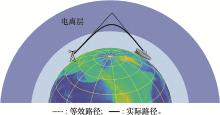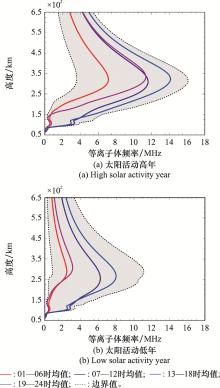Systems Engineering and Electronics ›› 2023, Vol. 45 ›› Issue (7): 1911-1919.doi: 10.12305/j.issn.1001-506X.2023.07.01
• Electronic Technology • Previous Articles Next Articles
Theoretical analysis of shortwave TDOA geolocation based on empirical ionospheric model
Chen LI, Chen ZHOU, Junming WANG, Mingjie LYU, Wei QIAO
- School of Electronic Information, Wuhan University, Wuhan 430072, China
-
Received:2022-03-21Online:2023-06-30Published:2023-07-11 -
Contact:Chen ZHOU
CLC Number:
Cite this article
Chen LI, Chen ZHOU, Junming WANG, Mingjie LYU, Wei QIAO. Theoretical analysis of shortwave TDOA geolocation based on empirical ionospheric model[J]. Systems Engineering and Electronics, 2023, 45(7): 1911-1919.
share this article
Table 1
Ionospheric equivalent reflection height distribution under different ionospheric backgrounds"
| 电离层背景 | 电离层反射高度/km | 总样本数 | |||||
| 220~240 | 240~260 | 260~280 | 280~300 | 300~320 | 320~340 | ||
| 太阳高年白天 | 3 966 | 8 | 0 | 17 | 41 | 0 | 4 032 |
| 太阳高年夜晚 | 128 | 9 | 0 | 318 | 1 523 | 1 046 | 3 024 |
| 太阳低年白天 | 3 946 | 6 | 1 | 53 | 26 | 0 | 4 032 |
| 太阳低年夜晚 | 108 | 10 | 0 | 146 | 973 | 1 446 | 2 683 |
| 1 | 李康, 丁国如, 李京华, 等. 无源定位技术发展动态及其应用分析[J]. 航空兵器, 2021, 28 (2): 104- 112. |
| LI K , DING G R , LI J H , et al. Development and application analysis of passive location technology[J]. Aviation Weapon, 2021, 28 (2): 104- 112. | |
| 2 | TORRIERI D J . Statistical theory of passive location systems[J]. IEEE Trans.on Aerospace and Electronic Systems, 1984, 20 (2): 183- 198. |
| 3 | GUO X , NI J L , LIU G S . Architecture and signal processing of sky wave over-the-horizon radar[J]. Radio Science, 2003, 38 (5): 373- 377. |
| 4 |
韩吉德, 王祖顺, 王春青. 全球电离层时空变化特性分析[J]. 测绘地理信息, 2012, 37 (6): 26- 29.
doi: 10.14188/j.2095-6045.2012.06.014 |
|
HAN J D , WANG Z S , WANG C Q . Analysis of global ionospheric spatiotemporal variation[J]. Journal of Geomatics, 2012, 37 (6): 26- 29.
doi: 10.14188/j.2095-6045.2012.06.014 |
|
| 5 | KOPYSOV A, KLIMOV I, ZAGIDULLIN Y, et al. The use of polarization characteristic of ionosphere for data communications[C]//Proc. of the International Conference on Mechanical Engineering, Automation and Control Systems, 2014. |
| 6 |
BENNETT J A . The calculation of Doppler shifts due to a changing ionosphere[J]. Journal of Atmospheric and Terrestrial Physics, 1967, 29 (7): 887- 891.
doi: 10.1016/0021-9169(67)90055-4 |
| 7 | 王倩. 电离层多径时延和多普勒频移的研究[D]. 西安: 西安电子科技大学, 2014. |
| WANG Q. Study on the multi-path time delay and Doppler shift of ionosphere[D]. Xi'an: Xidian University, 2014. | |
| 8 | 刘选谋. 无线电波传播[M]. 北京: 高等教育出版社, 1987. |
| LIU X M . Radio wave propagation[M]. Beijing: Higher Education Press, 1987. | |
| 9 |
CHAPMAN S . The absorption and dissociative or ionizing effect of monochromatic radiation in an atmosphere on a rotating earth[J]. Proceedings of the Physical Society, 1931, 43 (1): 26.
doi: 10.1088/0959-5309/43/1/305 |
| 10 |
CROFT T A , HOOGASIAN H . Exact ray calculations in a quasi-parabolic ionosphere with no magnetic field[J]. Radio Science, 1968, 3 (1): 69- 74.
doi: 10.1002/rds19683169 |
| 11 | RADICELLA S M . The NeQuick model genesis, uses and evolution[J]. Annals of Geophysics, 2009, 52 (3/4): 417- 422. |
| 12 | BENT R B , LLEWELLYN S K , NESTERCZUK G , et al. The development of a highly-successful worldwide empirical ionospheric model and its use in certain aspects of space communications and worldwide total electron content investigations[J]. Effect of the Ionosphere on Space Systems and Communications, 1975, 1 (1): 13- 28. |
| 13 | BILITZA D . International reference ionosphere 1990[J]. Planetary & Space Science, 1992, 40 (4): 544. |
| 14 |
BILITZA D , ALTADILL D , TRUHLIK V , et al. International reference ionosphere 2016: from ionospheric climate to real-time weather predictions[J]. Space Weather, 2017, 15 (2): 418- 429.
doi: 10.1002/2016SW001593 |
| 15 |
DYSON P L , BENNETT J A . A model of the vertical distribution of the electron concentration in the ionosphere and its application to oblique propagation studies[J]. Journal of Atmospheric and Terrestrial Physics, 1988, 50 (3): 251- 262.
doi: 10.1016/0021-9169(88)90074-8 |
| 16 |
KOHNLEIN W . Electron density models of the ionosphere[J]. Reviews of Geophysics, 1978, 16 (3): 341- 354.
doi: 10.1029/RG016i003p00341 |
| 17 | JONES R M , STEPHENSON J J . A versatile three-dimensional ray tracing computer program for radio waves in the ionosphere[M]. Washington: US Department of Commerce, Office of Telecommunications, 1975. |
| 18 | 索玉成. 电离层短波射线追踪[J]. 空间科学学报, 1993, 13 (4): 306- 312. |
| SUO Y C . Ionospheric shortwave ray tracing[J]. Chinese Journal of Space Science, 1993, 13 (4): 306- 312. | |
| 19 | 汪珺. 测向交叉定位技术[J]. 电子科技, 2011, 24 (7): 129- 132. |
| WANG J . Direction finding cross positioning technology[J]. Electronic Science and Technology, 2011, 24 (7): 129- 132. | |
| 20 | LAI K. A real-time HF single-station location system development[C]//Proc. of the International Conference on Radar, 2008: 307-310. |
| 21 | KAUNE R. Accuracy studies for TDOA and TOA localization[C]//Proc. of the 15th International Conference on Information Fusion, 2012: 408-415. |
| 22 | WANG G H, JIANG X, RAZUL S G, et al. Passive TDOA and DOA based HF geolocation without ionosphere information[C]//Proc. of the 10th International Conference on Information, Communications and Signal Processing, 2015. |
| 23 |
HO K C , CHAN Y T . Solution and performance analysis of geolocation by TDOA[J]. IEEE Trans.on Aerospace and Electronic Systems, 1993, 29 (4): 1311- 1322.
doi: 10.1109/7.259534 |
| 24 | 周霞, 杨琳, 王英翔. 短波测向定位误差分析[J]. 中国无线电, 2021, 1 (7): 85- 89. |
| ZHOU X , YANG L , WANG Y X . Analysis of shortwave direction finding and positioning error[J]. China Radio, 2021, 1 (7): 85- 89. | |
| 25 | 马燕, 刘丽. 美国开展高频定立项目[J]. 国际电子战, 2012, 1 (10): 87- 87. |
| MA Y , LIU L . United States launches high-frequency settling project[J]. International Electronic Warfare, 2012, 1 (10): 87- 87. | |
| 26 |
JAIN A , PAGANI P , FLEURY R , et al. HF source geolocation using an operational TDoA receiver network: experimental results[J]. IEEE Antennas and Wireless Propagation Letters, 2018, 17 (9): 1643- 1647.
doi: 10.1109/LAWP.2018.2860459 |
| 27 | JAIN A, PAGANI P, FLEURY R, et al. Passive HF geolocation using TDoA based receiver network[J/OL]. [2022-03-21]. http://hal.sciencelhal-01985446. |
| 28 |
YANG K , WANG G , LUO Z Q . Efficient convex relaxation methods for robust target localization by a sensor network using time differences of arrivals[J]. IEEE Trans.on Signal Processing, 2009, 57 (7): 2775- 2784.
doi: 10.1109/TSP.2009.2016891 |
| 29 | WANG T, HONG X L, LIU W, et al. Geolocation of unknown emitters using TDOA of path rays through the ionosphere by multiple coordinated distant receivers[C]//Proc. of the IEEE International Conference on Acoustics, Speech and Signal Processing, 2018: 3509-3513. |
| 30 |
ZHANG T N , MAO X P , HOU Y G , et al. An improved grid-search method for the identity-test of ionosphere-layer virtual heights via TDOA measurements[J]. IEEE Access, 2019, 7, 92861- 92870.
doi: 10.1109/ACCESS.2019.2927656 |
| 31 | 张铁男. 基于电离层反射信号的多站短波时差定位技术研究[D]. 哈尔滨: 哈尔滨工业大学, 2019. |
| ZHANG T N. Research on multi-station shortwave time diffe-rence positioning technology based on ionospheric reflection signals[D]. Harbin: Harbin Institute of Technology, 2019. | |
| 32 | HASELGROVE J . Ray theory and a new method of ray tracing[M]. London: Physics in the Ionosphere, 1955. |
| 33 | JONES R M . A three-dimensional ray-tracing computer program[J]. Radio Science, 1968, 3 (1): 93- 95. |
| 34 | 王严, 李雪, 尹文禄, 等. 电离层吸收衰减预测方法的比较研究[J]. 电波科学学报, 2022, 37 (1): 129- 136. |
| WANG Y , LI X , YIN W L , et al. A comparative study on prediction methods of ionospheric absorption and decay[J]. Chinese Journal of Radio Science, 2022, 37 (1): 129- 136. | |
| 35 | RAWER K . Wave propagation in the ionosphere[M]. Berlin: Springer Science and Business Media, 2013. |
| 36 | REILLY M H . Ionospheric true height profiles from oblique ionograms[J]. Radio Science, 1985, 20 (3): 280- 286. |
| 37 | 攸阳, 钱志刚, 李吉宁, 等. 短波时差定位中电离层参数对定位影响仿真[J]. 电波科学学报, 2017, 32 (4): 462- 466. |
| YOU Y , QIAN Z G , LI J N , et al. Simulation of influence of ionospheric parameters on positioning in shortwave time diffe-rence positioning[J]. Chinese Journal of Radio Science, 2017, 32 (4): 462- 466. | |
| 38 | KAY S M . Fundamentals of statistical signal processing: practical algorithm development[M]. London: Pearson Education, 2013. |
| 39 | CHAN Y T , HO K C . A simple and efficient estimator for hyperbolic location[J]. IEEE Trans.on Signal Processing, 1994, 42 (8): 1905- 191. |
| 40 | 黄光亮. 电离层频高图转换方法及应用研究[D]. 武汉: 武汉大学, 2017. |
| HUANG G L. Ionospheric frequency-height map conversion method and application research[D]. Wuhan: Wuhan Univer-sity, 2017. |
| [1] | LU Zhiyu, BA Bin, REN Yanqing, WANG Daming. Direct trajectory determination algorithm based on evolutionary particle filter [J]. Systems Engineering and Electronics, 2018, 40(5): 968-975. |
| [2] | TIAN Qiang, FENG Dazheng, YANG Fan, HU Haoshuang. Joint-TOA-based synchronization and localization via linear-correction technique [J]. Systems Engineering and Electronics, 2018, 40(2): 245-249. |
| [3] | SHENG Dan, WANG Guo-hong, ZHANG Xiang-yu. Maneuvering target tracking based on waveform agility with multi-sensor [J]. Systems Engineering and Electronics, 2015, 37(3): 485-491. |
| [4] | LI Shao-dong, PEI Wen-jiong, YANG Jun, HU Guo-qi. OMP reconstruction algorithm via Bayesian model and its application [J]. Systems Engineering and Electronics, 2015, 37(2): 246-252. |
| [5] | HUANG Xiang-dong, YU Jia, MENG Tian-wei, WANG Zhao-hua. Double subsegment measuring phase method derived from all phase FFT [J]. Systems Engineering and Electronics, 2014, 36(11): 2149-2155. |
| [6] | LIU Zhen, WEI Xi-zhang, LI Xiang. Statistical Cramer-Rao lower bound and its maximum likelihood estimation of random modulated signal parameters [J]. Journal of Systems Engineering and Electronics, 2012, 34(10): 1980-1986. |
| [7] | YANG Li-bo,TAN Lu-lu,YANG Ru-liang,YU Wei-dong. Missile location for synthetic aperture radar scene matching midcourse guidance [J]. Journal of Systems Engineering and Electronics, 2010, 32(11): 2416-2420. |
| Viewed | ||||||
|
Full text |
|
|||||
|
Abstract |
|
|||||







